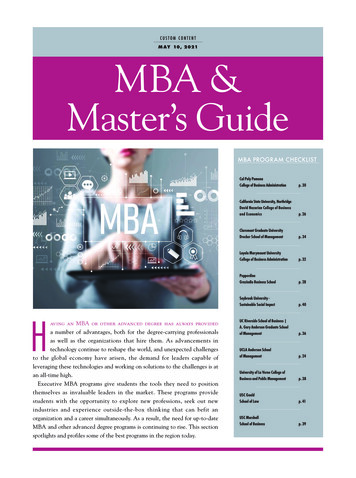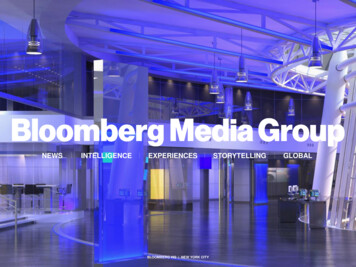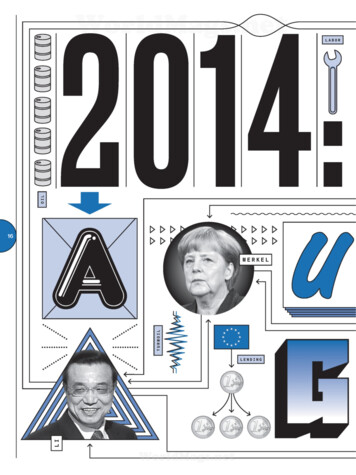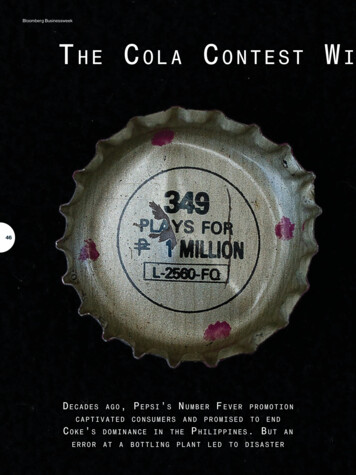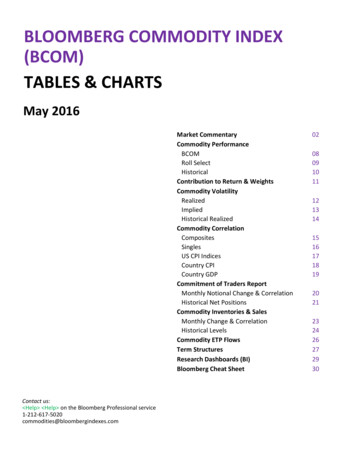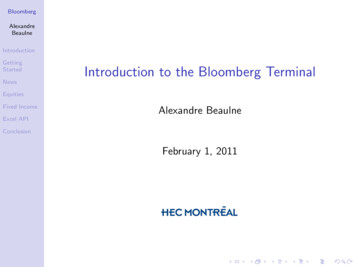
Transcription
Bloomberg L.P.731 Lexington AveNew York, NY 10022Tel 1 212 318 2000bloomberg.comFebruary 10, 2017Dear Judges,“Here in Libya I can make you disappear, and nobody will ever hear back from you.”When Libyans began rebuilding their shattered country after the death of dictator Moammar Qaddafi, theyfaced a fiendishly complex challenge: Reclaiming the billions of dollars of oil revenue his regime had movedabroad through deals with major banks.As Matthew Campbell and Kit Chellel showed in a rollicking international cover story for BloombergBusinessweek, much of it ended up with none other than Goldman Sachs—specifically, through a series ofopaque derivatives transactions engineered by an ambitious junior banker, Youssef Kabbaj. A rising starwho'd gone from obscurity in Morocco to the top table of international finance in a matter of months, Kabbajwined and dined the Libyans in London, Dubai, and Marrakesh, striking up a close friendship with the kidbrother of Mustafa Zarti, the director of the fledgling Libyan Investment Authority.The unlikely partnership between the most aggressive wolf on Wall Street and the country still known as theGreat Socialist People's Libyan Arab Jamahiriya seemed like a win-win at first. But it soon descended into atangled, costly scandal that's still being unwound. After an explosive confrontation with Zarti, who claimedhe'd been hoodwinked by Goldman, Kabbaj had to flee Libya with his life under threat and his career inshambles. The Libyans lost every penny of the 1.2 billion they invested, and blamed their former friend—and the firm he represented.Drawing on thousands of pages of legal documents and dozens of interviews with participants in the deals,Campbell and Chellel offered a rare glimpse behind the closed doors of the world's most secretive bank,explaining how Goldman convinced Libya's young, inexperienced investment team to commit to huge tradesthey may never have understood. Their story, which was read online by more than 250,000 people and wasthe most popular of the week at Longform.org, rendered those complicated financial concepts understandableto a broad readership. In doing so, it showed how bankers can use complex transactions to beguile clientsinto what's essentially high-stakes gambling, in which the House of Goldman usually wins.The piece was widely praised by competitors at the Financial Times, Wall Street Journal, and New YorkTimes, with Foreign Policy's Robbie Gramer praising its “phenomenal investigative reporting” and YahooFinance's managing editor, Sam Ro, calling it “incredible.” The richness of Campbell and Chellel's work layin the details that turned the dry perambulations of international finance into a riveting narrative. Oneexample: early in his courtship of the Libyans, Kabbaj shipped a box of books to Tripoli to provide the basisfor a financial library. In addition to dry tomes on asset allocation and economics, he included several copiesof Liar's Poker, Michael Lewis's tale of smart bankers who made a killing, and dumb clients who gotscrewed.I’m proud to nominate it for the Gerald Loeb Award for feature writing.Sincerely,
Gerald Loeb AwardFor Feature WritingBloomberg Businessweek“Hot Mess: How Goldman Lost Libya’s Money”Matthew Campbell and Kit Chellel1. “Hot Mess: How Goldman Sachs Lost 1.2 Billion of Libya's Money,” September 29,2016 chs-libya/
Photograph by Juan ArredondoSeptember 29, 2016 http://bloom.bg/2cDkVmVHot Mess: How GoldmanSachs Lost 1.2 Billion ofLibya’s MoneyWhen Wall Street’s most aggressivebank took on the world’s mostincendiary client, someone was goingto make a killing.By Matthew Campbell and Kit Chellel
September 29, 2016 http://bloom.bg/2cDkVmVYoussef Kabbaj, Goldman Sachs securities salesman. Illustration: 731Moammar Qaddafi’s Libya was a miserable place for a business trip.In 2008, a few years after renouncing its nuclear and chemical weapons program, thedesert nation remained a menacing and ugly place, with cratered highways, awful restaurants with no booze, and Qaddafi’s leathery visage everywhere, staring balefully downfrom billboards. The dreary capital, Tripoli, sat at the edge of the Sahara, in the leastbarren sliver of a country defined in the West by dictatorship, terrorism, and billions ofdollars’ worth of oil.Goldman Sachs’s Youssef Kabbaj was one of the few that enjoyed the commute. A securities salesman based out of the bank’s London headquarters, Kabbaj found that Libyareminded him of his native Morocco, and he considered the ruins in Tripoli’s old quarterenchanting. The city had a single decent hotel, the Corinthia, a crescent hulk the color ofsand, and that year Kabbaj was such a frequent guest that he stored a rack of pressed suitsthere at all times. With slick black hair, round cheeks, and a mischievous smile, he wasfluent in English, French, Arabic, and the language of international finance.Qaddafi’s peaceful turn had reopened Libya to Western banking for the first time intwo decades. Its 60 billion in oil wealth, no longer dammed up by international sanctions, was ready to flood into the market, as directed by the Libyan Investment Authority,Qaddafi’s brand-new sovereign wealth fund. With his North African pedigree, Kabbaj had
September 29, 2016 http://bloom.bg/2cDkVmVbeen one of the first at Goldman to spot the opportunity. The LIA had become his biggestclient, transforming him in a year from rookie salesman into possibly the No. 1 rainmakerat the world’s most profitable investment bank. He was 31 years old.On July 23, 2008, Kabbaj was in his room at the Corinthia, waiting anxiously for hismobile phone to ring. It finally did around 9 a.m., and he grabbed a pen and paper to takenotes. On the line was Michael Daffey, a senior Goldman executive in London. Daffeypraised Kabbaj’s work in Libya and said that after some negotiation, the bank was willingto guarantee him 9 million in pay. It was an astonishing sum, even at Goldman.Kabbaj immediately asked for more. He knew he’d been instrumental in extracting anunusual amount of money from a highly unusual client. Who else on the planet could sella billion dollars of derivatives to a regime whose theatrical despot slept in a tent under anall-female warrior guard?By now Kabbaj was running late, and Nick Pentreath, a South African colleague on oneof his first trips to Libya, was knocking on his hotel room door to hurry him up. They’dbeen summoned to a late-morning meeting by the LIA’s deputy chief executive, MustafaZarti, a Qaddafi family friend. Zarti kept a ceremonial sword mounted above his desk—and was rumored to wave it around before visitors who displeased him. The markets werescary enough that summer. Bear Stearns, an American investment bank, had collapsed inMarch, and there were rumors that Lehman Brothers could be next. Zarti wanted Kabbajto give him an update on Libya’s portfolio at Goldman.Pentreath and Kabbaj took a short taxi ride to the Al-Fateh Tower, a two-pronged structure of stupendous ugliness that loomed over Tripoli in a style that might be called totalitarian postmodern. The LIA’s offices were on the 22nd floor. Usually, Kabbaj was shownright in, but this time he and Pentreath were kept waiting for what felt like hours, watchedover by an oversize portrait of Qaddafi in military garb. Something wasn’t quite right.Finally, as Kabbaj was called into a boardroom next to Zarti’s office, he recognized threebankers from the French bank Société Générale—Goldman’s main rival for the LIA’s cash.He saw with alarm that they were holding term sheets for Goldman deals and grinning athim as he walked past.Kabbaj steeled himself and began to address Zarti. The LIA’s day-to-day chief was 38,with plump features, thinning black hair, and a Marlboro Red forever at his lips. He glowered as Kabbaj said that Goldman had some great new trading ideas. Zarti cut him off,saying he wanted to talk about deals that had already been done. Kabbaj started drawingon a whiteboard, running through basic concepts like how options could be “in the money”or “out of the money,” and Pentreath began a technical explanation of the derivatives.Zarti again interrupted. “Youssef,” he said, “I’m asking you.” Before Kabbaj could say
September 29, 2016 http://bloom.bg/2cDkVmVNick Pentreath, Goldman Sachs securities salesman. Illustration: 731much more, Zarti exploded. Screaming in a mix of English and Arabic, he accused Kabbajof deceiving the LIA into deals it didn’t understand. He called Goldman “a bank ofMafiosi” and said that he could behave like a Mafioso, too. He stormed out of the room,leaving Kabbaj, Pentreath, and a clutch of LIA staffers in a Marlboro haze.Shaken, Kabbaj asked Zarti’s aides what had just happened. None had an answer. After afew minutes, Zarti burst back in, angrier than ever. Catherine McDougall, an Australianlawyer who was in the office that day, later recalled Zarti’s words as along the lines of “F--your mother, f--- you, and get out of my country.” Kabbaj and Pentreath packed up theirthings.Zarti followed them into the corridor. If Kabbaj didn’t make amends, he shouted, “we willgo after your own family in Morocco!” The Al-Fateh Tower elevators were agonizinglyslow to arrive. “What are you still doing here? Get out of my building!” Zarti screamed. Hetold Pentreath that if he didn’t get in the lift soon, he’d throw him out the window.Kabbaj was white with shock. Zarti had saved his most chilling remark for him. “You areonly a Moroccan here in Libya,” he said. “I can make you disappear, and nobody will everhear back from you.”The story of Goldman’s seduction of Libya—based on court evidence, testimony fromwitnesses, and interviews with people who were involved in the transactions—is as
September 29, 2016 http://bloom.bg/2cDkVmVMustafa Zarti, Libyan Investment Authority deputy chief executive. Illustration: 731; Basedon photograph by Rene Van Bakalbrief as it was costly. Barely 12 months elapsed between Zarti’s first tour of the bank andhis threat to murder its brightest young star, and Libya wound up losing 1.2 billion.Goldman enjoyed its payday, the exact size of which it has never disclosed. But whateverthe level, the matter is now before a London judge, and the Libyans have a chance toextract an even more damaging toll.For 65 million years, a mile beneath what’s now the Libyan Desert, the supercompressedremains of billions of dinosaurs, plants, and other Cretaceous organisms have been gentlycooking into crude. Human ancestors were using tools in the region 200,000 years ago,and early civilizations came to be conquered in turn by the Phoenicians, the Greeks, theRomans, and others in a chain of foreign rule that reached the modern era. Italy relinquished Libya after World War II, and the nation declared independence in 1951. Eightyears later, Western drillers struck what remain the largest oil reserves in all of Africa.In 1969, while Libya’s U.S.-allied king was out of the country, a strikingly handsomeyoung military officer pulled off an ambitious coup. Initially, Moammar Qaddafi ruled asa garden-variety Arab nationalist, like those who’d recently taken over Egypt, Iraq, andSyria. He gradually became more erratic, writing checks to the Black Panthers and RedBrigades and declaring himself supreme leader of the Great Socialist People’s Libyan Arab
September 29, 2016 http://bloom.bg/2cDkVmVJamahiriya. By the 1980s, Qaddafi seemed to relish his image as a villain out of a ChuckNorris movie, blamed for a Berlin nightclub bombing, targeting U.S. servicemen in theregion, and downing a Pan Am jet over Scotland, killing 270 people. Ronald Reagan calledhim the “mad dog of the Middle East,” an image that stuck even as Qaddafi extended hiscanny rule into the 21st century.U.S.-led sanctions steadily crippled the Libyan economy. Then, in 2003, Qaddafi watchedAmerican troops invade Iraq and drag a filthy Saddam Hussein out of a spider hole. Afew days later, Qaddafi offered to give up Libya’s WMD programs. Eager to reward goodbehavior, the U.S. eased sanctions, restoring full relations in 2006. Qaddafi might havebeen a brutal tyrant who forced citizens to study his Green Book, but he was abruptly aman the West could do business with. So complete was the reversal in his fortunes thaton one visit to New York he struck a deal to pitch his Bedouin tent on the WestchesterCounty lawn of Donald Trump.The reemergence of Libya, and its vast oil wealth, coincided with an era of nearly unbridled avarice on Wall Street—and nowhere more so than at Goldman Sachs. The sameyear that Qaddafi established the LIA, Goldman posted the largest profit in Wall Streethistory. The bank paid employees an average of 622,000, with many times that amountavailable for bankers who nailed down the biggest deals. A stupendously wealthy petrostate desperate to buy into a bull market was a dream client—the kind of “elephant,” inGoldman argot, that could make careers.Kabbaj joined Goldman’s London office in 2006. Born to a wealthy Rabat family, he’dattended the elite Lycée Louis-le-Grand in Paris, going on to a degree in engineering atMIT. Goldman hired him after a stint at a Moroccan bank, initially offering Kabbaj a jobas one of its “quants”—the math whizzes who devise algorithmic trading strategies behindclosed doors. He insisted on a role in sales, convinced he could climb the ladder faster bybeing close to clients. The only available post was on a team covering Africa—at the time,a backwater within the firm that generated next to no revenue.Kabbaj was one of the first to realize that to make big money in Africa, Goldman wouldhave to tap Libya, telling a colleague in February 2007 that its wealth fund was “one of ourkey prospects.” He cold-called the LIA and was told that Zarti was due in London soonand would listen to what Kabbaj and his colleagues had to say.Zarti’s background underscored the essential weirdness of doing business in Libya,where there were few private companies and credit cards didn’t exist until 2005. Beforecoming to the LIA, he’d worked at a fund run by OPEC and led a modest tuna-fishingconcern. He also happened to be a close friend of Saif Qaddafi, Moammar’s son, whichin Libya was the best possible qualification for a government job. Zarti favored Italiansuits in loud colors, paired with chunky watches from Audemars Piguet, and he was often
September 29, 2016 http://bloom.bg/2cDkVmVDriss Ben-Brahim, Goldman Sachs partner. Illustration: 731accompanied at meetings by his elegant assistant Sofia Wellesley, the aristocratic granddaughter of the Duke of Wellington, who would make introductions and smooth outZarti’s rough manners. (Zarti declined interview requests sent through a spokesman.)Zarti and Wellesley were given the VIP treatment when they arrived at Goldman’s FleetStreet offices on the afternoon of July 6, 2007, waved past security and escorted ontothe trading floor by Kabbaj. The Libyan seemed awed by the cavernous space, clangingwith the noise of late-day trading. Zarti kept asking if he could smoke and kept gettingtold he couldn’t. After the tour, he was led into a glass-walled office to meet Goldmanpartner Driss Ben-Brahim. Tall and charismatic, with dual Austrian and Moroccan citizenship, Ben-Brahim was well-known in the Arab world thanks to reports that he’d beenpaid a 30 million ( 54 million) bonus in 2004. (Goldman denied the story at the time.)Ben-Brahim gave Zarti a sense of Goldman’s scale: It had 26,000 employees, 69 billionin revenue, and 9.5 billion in profit. Zarti said, “So if you had a flag, you’d be a country.”Pleased, he invited Goldman to come to Libya to talk about whether the LIA should makesome small “appetizer” investments—something in the region of 100 million to 200million.Soon after, a group of Goldman bankers converged on Tripoli, including Ben-Brahim;Kabbaj and another salesman, Laurent Lalou; and Edward Eisler, a senior trader. On the
September 29, 2016 http://bloom.bg/2cDkVmVLaurent Lalou, Goldman Sachs vice president, salesman. Illustration: 731ground, Libyan officials confiscated a bottle of wine intended as a gift. Alcohol was bannedin Qaddafi’s Libya, and speed limits didn’t really exist, as the bankers learned on a whiteknuckle ride into town, their local drivers tearing down the decrepit roads at more than90 miles an hour. The Goldman delegation stayed at the Corinthia, which, because of itsmonopoly on business travel, charged upwards of 500 for a basic room. Ben-Brahimsaid, half-seriously, that Goldman should buy it.First impressions of the LIA were unpromising. The Al-Fateh Tower seemed like itcouldn’t possibly be the headquarters of a multibillion-dollar investment fund. The25-story structure had been built without enough elevators, which meant long waits ina dingy lobby full of cell phone shops. A ring-shaped roof deck was supposed to rotatebut didn’t. The LIA’s floor was a raw construction site with almost no furniture. But suchconcerns receded when LIA’s chief executive officer, Mohammed Layas, an experiencedbanker, explained the fund’s ambitions. Qaddafi himself, who communicated with the LIAthrough missives transcribed by a man known as “Qaddafi’s quill,” wanted large, quickreturns to support state spending.“Investment opportunities with this account is [sic] one of the largest I’ve ever seen,”Goldman partner Yusuf Aliredha wrote afterward. “We are all over them.” Goldmanwanted to strike quickly, as other firms began to notice the giant pot of money in Libya.
September 29, 2016 http://bloom.bg/2cDkVmVThe day Goldman arrived, Wellesley noted in an e-mail that “there are private jetsblocking Tripoli International.”Ben-Brahim was on vacation in the south of France later in July when Zarti got in touch,asking him to meet on a yacht that had just pulled into Cannes from Saint-Tropez. AsBen-Brahim climbed aboard the vessel, he realized that it belonged to Saif Qaddafi, thecolonel’s heir apparent, who had an international reputation as Libya’s reformer-inchief. After the three men spoke, Ben-Brahim thought there could be even more moneyin Libya than Goldman realized. The country expected “gigantic” new oil and gas finds,he wrote in a debrief to colleagues, who began to gossip about the bank’s exotic newclient—including tales, never confirmed, that the yacht meeting featured a cameo by oneof Saif’s pet white tigers.Ben-Brahim instructed Kabbaj to “stay a lot in Tripoli. It’s important you stay superclose to the client on a daily basis. Teach them, train them, dine them.” Aliredha agreed.“You need to own this client,” he wrote. “This is a once in a career opportunity.” Kabbajtraveled to Tripoli four more times before the end of September, becoming such afixture at the Al-Fateh Tower that he eventually got his own desk. He spent part of histime taking the LIA’s junior people “through Finance 1.00,” as he put it, using MIT’sterm for an introductory course. The fund’s young staff had been recruited from theLibyan diaspora with help from Monitor, the Massachusetts-based consulting firm, andknew little about complex securities deals. Kabbaj helped stock an in-house library. Inaddition to dry tomes on asset allocation and pop-economics hits such as The BlackSwan, he bought the Libyans a few copies of Liar’s Poker, Michael Lewis’s seminal taleof bond salesmen screwing over clients. (Amazon.com didn’t deliver to Libya, so Kabbajordered the books to London and had a colleague lug them to Tripoli.)Kabbaj also entertained the Libyans when they came to London, expensing a 757 sushidinner at Nobu and taking them to the Lord of the Rings musical. Lalou took a juniorLIA employee to Paris to watch England’s rugby team play South Africa. (Goldman saysthe hospitality was in line with what other banks also provided the fund.) Nothing wastoo much trouble. One banker, Jaber Jabbour, declared to an LIA employee by e-mail,“You are brothers and friends before clients.”By late September 2007, the LIA was ready to proceed with its first substantial investment with Goldman: 350 million into two funds called Petershill and Mezzanine. Libyahad signed a document describing itself as a “market counterparty”—large and sophisticated enough not to need special regulatory protection. Ben-Brahim and Aliredha flewagain to Tripoli early in October, chartering a jet from Qaddafi’s favorite vendor to givetheir arrival the necessary gravitas.It was Ramadan, and the Goldman team joined LIA executives for a traditional
September 29, 2016 http://bloom.bg/2cDkVmVSaif Qaddafi, Moammar’s son and heir apparent. Illustration: 731; Based on photograph byKason Florio/Corbis/Getty Imagesbreaking-the-fast dinner at the Corinthia. Layas, the LIA chief executive, was at the headof the table. The LIA had previously indicated that it was planning to split its businessequally among as many as 20 banks, but as they ate, Goldman’s executives suggesteda more exclusive relationship. They proposed a dedicated team of partners, access toresearch and training, and the opportunity to join in Goldman’s own proprietary investments—a “strategic partnership.” Both sides could make money, Ben-Brahim told thegroup, citing Goldman’s long-standing informal motto of being “long-term greedy.” TheLibyans were receptive. Ben-Brahim and Aliredha flew straight back to London after themeal, leaving Jabbour and Kabbaj behind to discuss Goldman’s proposals. They werebleary-eyed, having just pulled an all-nighter preparing a presentation. A suggested firststep: “Buy strategic stakes in key undervalued companies.”By January 2008, the Libyans had some companies in mind. The talk at the LIA, Kabbajlearned, was that Qaddafi wanted to emulate the leaders of Qatar, who’d invested in theshares of troubled banks. One target was Citigroup, which Abu Dhabi’s sovereign wealthfund had put 7.5 billion into less than two months before. On Jan. 15, Kabbaj textedthe head of the LIA’s equities team to note that Citi shares were down, creating a buyingopportunity: “It is time to do the trade!!!”
September 29, 2016 http://bloom.bg/2cDkVmVThe Libyans made two trades later that month, totaling 200 million. But this wasn’ta simple purchase of shares—it was a complex derivatives deal, or as Goldman Sachsdescribed it later, “a cash-settled forward purchase agreement for Citigroup shares withdownside protection in the form of a put option at the same price as the forward.” Moresimply, if Citi shares rose, as the LIA was betting, the fund stood to gain many times itsinitial investment. If the shares fell by a certain amount, the fund could lose everything.The structure was potentially more lucrative than a conventional purchase of equity andalso significantly riskier—while resulting in far higher profits for Goldman.Whether the LIA understood it wasn’t actually investing in Citi is disputed. Whateverthe case, the fund proceeded a few weeks later with another large deal, a similar wageron the French utility EDF Group that cost it almost 120 million (then 175 million) inpremiums.Word was getting around the financial sphere that Goldman had landed an Africanelephant. Kabbaj discovered that Société Générale was also pursuing megadeals withthe LIA. “People are spreading that we made a lot of money with LIA and we screwedthem,” Kabbaj texted a colleague from Tripoli. “Even though this is of course uncorrect[sic], Pnls [profit and loss figures] have to become super secret.”Kabbaj began spending more time with the Libyans and bought some of them iPods. Afew came to London in February for training at Goldman, with the firm covering theirhotels and dinners. There, Kabbaj could entertain the Libyans in a capital with incomparably greater diversions than Tripoli. At Zuma, a bankers-and-Bentleys Japanese restaurant in Knightsbridge, he expensed a 1,009 dinner; at The Playroom lounge, he put 1,573 on his corporate card. They went to see Chicago and, records indicate, the Lordof the Rings musical again.To help plan the training sessions, one of Kabbaj’s colleagues e-mailed to ask aboutthe level of the Libyans’ knowledge of derivatives. He responded: “Baaaaaaaasic.” Inanother exchange, Kabbaj’s manager, Lalou, told a colleague he’d “just delivered a pitchon structured leveraged loans to someone who lives in the middle of the desert with hiscamels.”Zarti had goals beyond the greater glory of Libya. He also wanted to help his youngerbrother, Haitem, learn the banking trade, preferably through an internship at Goldman.Kabbaj wouldn’t disappoint his best client.Kabbaj found it easy to connect with Haitem, who was 25, shy, and soft-spoken—nothing like his intense sibling. Both he and Kabbaj were single and from importantNorth African families. They spent the weekend together in Morocco in late Februaryand then flew business class to Dubai, where Kabbaj had offered to take Haitem to a
September 29, 2016 http://bloom.bg/2cDkVmVMohammed Layas, LIA chief executive officer. Illustration: 731; Based on photograph byBank ABCGoldman conference, checking into the five-star Ritz-Carlton, all at the firm’s expense.Just after arriving, Kabbaj used his company BlackBerry to get in touch with a prostitute who went by the name Michella. “Hi darling, do you remember me? Youssef fromLondon,” he texted. “Just arrived in dubai. Available tonight, with a friend?” Theyhaggled over price before Kabbaj agreed to pay 300, with one condition: “Your friendhas to be as good looking as you.” There is no record of what happened next, but thefollowing day, Kabbaj texted Haitem to say he needed a rest: “Going to the hotel. I amdead.” A couple of nights later, Kabbaj wrote that he’d stay in, “Getting back to god’sway incha allah.”Immediately after returning from Dubai, Haitem sent Kabbaj his résumé, which didn’tfit the bank’s typical hiring profile. Haitem listed an MBA from the Vienna campus ofWebster University, an institution based in St. Louis with branches mostly near U.S.military bases, and his most recent work experience was at a “Video Club” in 2003,where he was “in charge of customer and reservation services.”Ben-Brahim, discussing the possibility of an internship by e-mail with two other partners, said he was “not sure what the best course of action is. We are running the risk of
September 29, 2016 http://bloom.bg/2cDkVmV‘upsetting’ [Mustafa] Zarti.” Yet by April, Goldman was prepared to offer a 6- to 12-weekgig to Haitem. The next day, Kabbaj told colleagues he’d spoken with Mustafa aboutfurther deals, and that the elder Zarti wanted “to give us something. If we can have himfocus, we should be in a good position.”The same month, Kabbaj again spent a weekend with Haitem in Marrakech and flewhim to Dubai a second time. Haitem dawdled in committing to the internship. Kabbajmessaged him a few days later, on April 23: “Can you start May 1? June 1? Mustafawants you to start asap.” Haitem indicated June. “OK. How long? Mustafa is killing us,”Kabbaj replied. The same day, the elder Zarti gave the go-ahead for Goldman to executeseveral trades of astonishing size, totaling more than 2.4 billion in notional value. Likethe Citi and EDF deals, they were “synthetic”—the LIA wasn’t actually buying sharesin the companies concerned, in this case Banco Santander, Allianz, Eni, and UniCredit.Kabbaj later called it “one of the biggest orders that GS has ever been given on singlenames.” (Goldman says Haitem’s internship had no impact on the trades. Haitemcouldn’t be reached for comment.)The scale of Goldman’s business with Libya was now being noticed at the highest levels.When Chief Executive Officer Lloyd Blankfein “found out how big the p&l [was] on therecent trade he started asking” questions about it, one executive said in an April e-mail.Another internal note later described Kabbaj as perhaps Goldman’s top salesman globally. In a text to Kabbaj, Ben-Brahim’s verdict was simple: “Bravo Youssef. Well done.You are a hero.”Goldman’s downfall in Libya began with the arrival of Catherine McDougall. A cheerfulAustralian lawyer at London firm Allen & Overy, she was just 26 when she arrived inTripoli on July 1, 2008, to begin an assignment with the LIA, which was seen as a majorpotential client. Although McDougall had traveled widely in the Middle East, Libya wasa new experience. It seemed frozen in the 1970s: There were no cinemas and barely anyshops. Foreigners lived in gated compounds under the watchful eyes of Qaddafi’s secretpolice, who LIA employees warned her had moles at the office. In London she’d bought acopy of In the Country of Men, a novel depicting the fearful atmosphere of 1970s Tripoli.When her Libyan counterparts saw it on her desk, they told her to put it away. Qaddafihad banned the book.McDougall was astonished by how little the LIA’s junior employees seemed to know.The legal department’s level of competence in dealing with complex legal documentation was “zero,” she wrote later in a witness statement. The problem was compoundedby rudimentary English and basic paperwork that was missing. She described the setupas like “an advertising company having no TVs.”One of McDougall’s tasks was to work with LIA staff on some paperwork for the
September 29, 2016 http://bloom.bg/2cDkVmVGoldman derivatives trades. Shewas struck by their affection forKabbaj, whom they considereda friend. One LIA staff membershowed McDougall Facebookphotos of Kabbaj hanging outwith the equity team. They toldher stories of expensive nights outin London and Morocco, coveredby his Goldman credit card. Asshe learned more, McDougallbegan to suspect the LIA teamdidn’t realize they hadn’tpurchased actual shares. No oneunderstood, she wrote, that if theunderlying stocks went the wrongway, “they could lose all theirmoney.” She asked to see the duediligence the LIA had performedbefore committing to the deals.They responded, she wrote, “Duewhat?”Featured in Bloomberg Businessweek, Oct. 3-Oct.
Bloomberg L.P. 731 Lexington Ave Tel 1 212 318 2000 New York, NY 10022 bloomberg.com February 10, 2017 Dear Judges, “Here in Libya I can make you disappear, and nobody will ever hear back from you.” When Libyans began rebuilding their shattered
